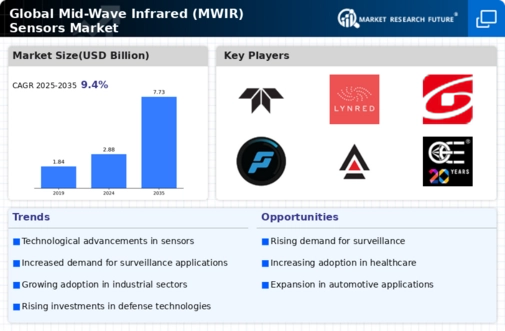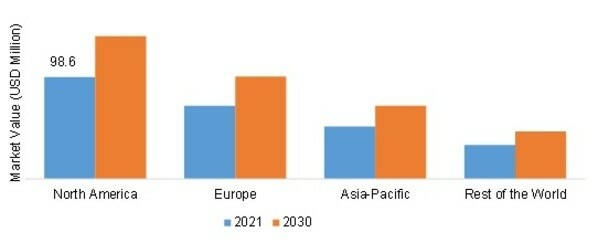Market Growth Projections
The Global Mid-Wave Infrared (MWIR) Sensors Market Industry is projected to experience substantial growth over the coming years. With a market value anticipated to reach 2.88 USD Billion in 2024 and further expand to 7.73 USD Billion by 2035, the industry is poised for a robust trajectory. The compound annual growth rate (CAGR) of 9.41% from 2025 to 2035 indicates a strong demand across various sectors, including defense, healthcare, and industrial automation. This growth is likely driven by technological advancements, increasing applications, and the rising need for efficient monitoring solutions.
Rising Adoption in Healthcare
The Global Mid-Wave Infrared (MWIR) Sensors Market Industry sees a rising adoption of MWIR sensors in healthcare applications. These sensors are utilized for non-invasive diagnostics, particularly in monitoring body temperature and detecting fever. The ability to provide accurate thermal imaging enhances patient care and facilitates early disease detection. Hospitals and clinics are increasingly integrating MWIR technology into their diagnostic equipment, reflecting a growing trend towards advanced medical imaging solutions. This shift is likely to contribute to the market's expansion, with projections indicating a growth to 7.73 USD Billion by 2035, driven by the increasing emphasis on healthcare innovation.
Environmental Monitoring and Safety
The Global Mid-Wave Infrared (MWIR) Sensors Market Industry is bolstered by the need for environmental monitoring and safety applications. MWIR sensors play a crucial role in detecting hazardous gases and pollutants, contributing to environmental protection efforts. Regulatory bodies are increasingly mandating the use of advanced sensing technologies to monitor air quality and ensure compliance with environmental standards. For instance, industries are deploying MWIR sensors to detect methane leaks in oil and gas operations, thereby enhancing safety measures. This growing emphasis on environmental sustainability is likely to propel the market forward, as organizations seek to adopt technologies that align with regulatory requirements.
Advancements in Industrial Automation
The Global Mid-Wave Infrared (MWIR) Sensors Market Industry is significantly influenced by advancements in industrial automation. Industries are increasingly adopting MWIR sensors for process monitoring, quality control, and predictive maintenance. These sensors enable real-time temperature measurements, which are crucial for optimizing production efficiency. For example, in the manufacturing sector, MWIR sensors facilitate the detection of heat anomalies in machinery, thereby preventing costly downtimes. As industries embrace automation, the market is expected to witness a compound annual growth rate (CAGR) of 9.41% from 2025 to 2035, indicating a strong alignment with technological progress.
Emerging Applications in Smart Cities
The Global Mid-Wave Infrared (MWIR) Sensors Market Industry is witnessing emerging applications within the context of smart cities. As urban areas evolve, the integration of MWIR sensors into smart infrastructure enhances public safety and resource management. These sensors are utilized for monitoring traffic patterns, detecting intrusions, and managing energy consumption. For example, smart streetlights equipped with MWIR sensors can adjust brightness based on pedestrian presence, optimizing energy use. This trend aligns with global initiatives to create sustainable urban environments, suggesting a promising future for MWIR technology as cities increasingly adopt smart solutions.
Growing Demand in Defense Applications
The Global Mid-Wave Infrared (MWIR) Sensors Market Industry experiences a notable surge in demand driven by defense applications. Military organizations increasingly rely on MWIR sensors for surveillance, reconnaissance, and targeting systems. The ability of these sensors to detect thermal signatures enhances situational awareness in various environments. For instance, the integration of MWIR sensors in unmanned aerial vehicles (UAVs) has proven effective in intelligence-gathering missions. As defense budgets expand, the market is projected to reach 2.88 USD Billion in 2024, reflecting a robust growth trajectory fueled by technological advancements and strategic investments.


 Source Secondary Research, Primary Research, MRFR Database and Analyst Review
Source Secondary Research, Primary Research, MRFR Database and Analyst Review






